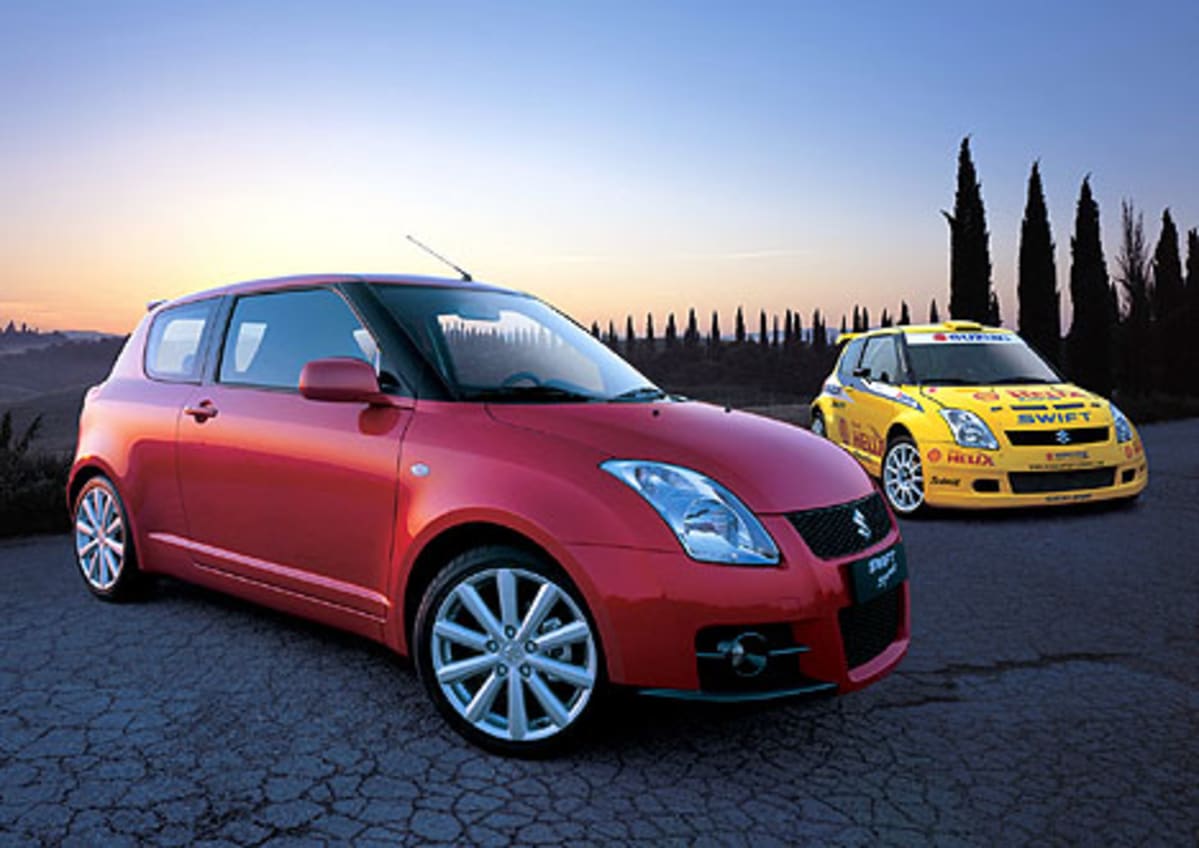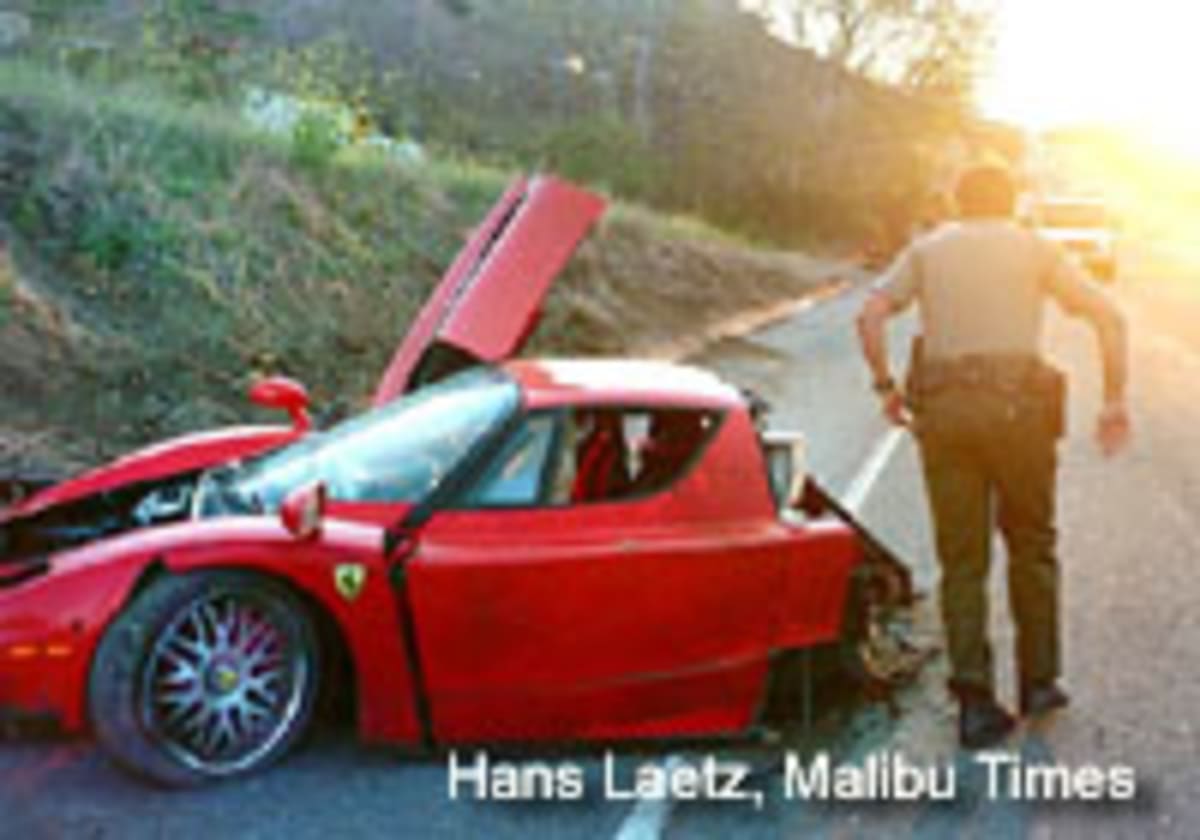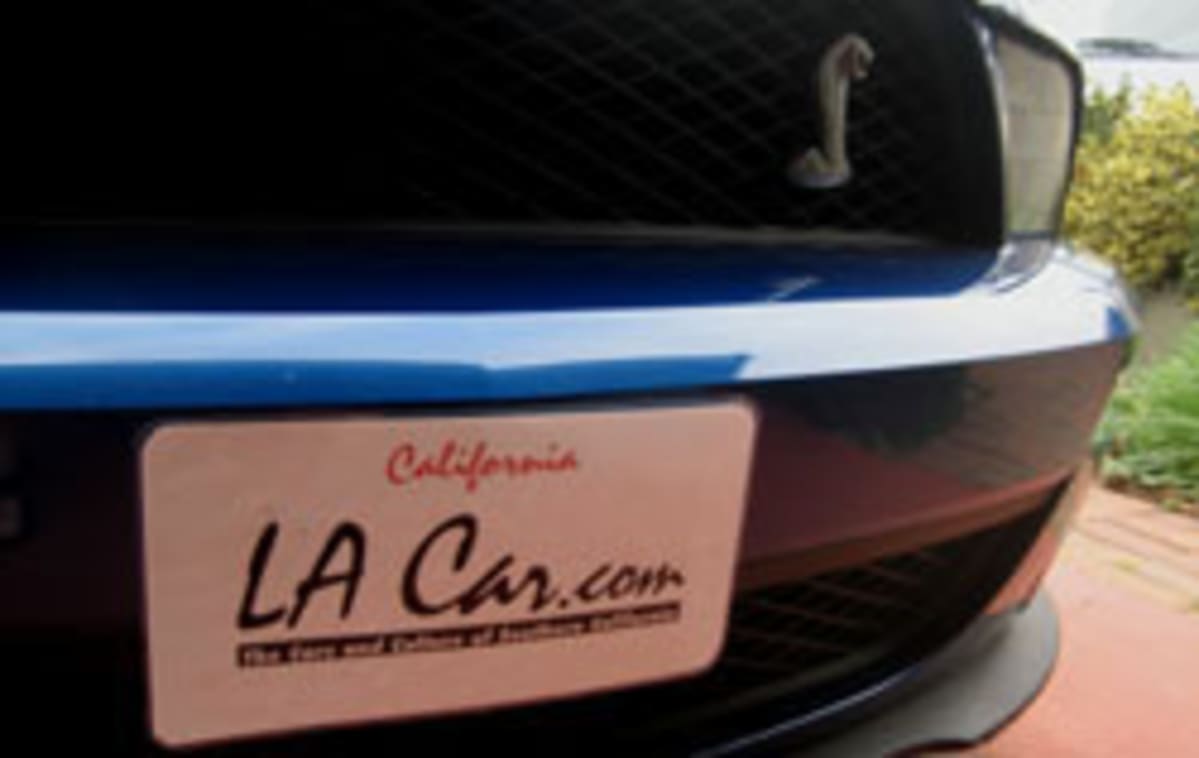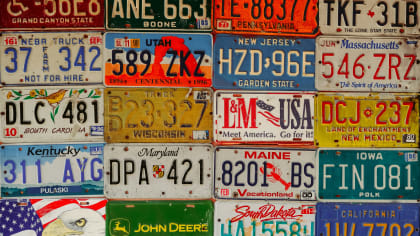BACK SEAT DRIVING - AUGUST 2007
This article is from our archives and has not been updated and integrated with our "new" site yet... Even so, it's still awesome - so keep reading!
Published on Wed, Aug 1, 2007
By: The LACar Editorial Staff

Suzuki Swift Sport
NAKANO:
BACK SEAT DRIVING
IMITATION OF LIFE
If imitation is the sincerest form of flattery, then Suzuki should be sincerely flattered
by the computer graphic rendition of the future Audi A1/S1 as it is portrayed in the August 13, 2007 issue of Autoweek. The
rendition bears a striking resemblance to the Suzuki Swift Sport, which is
presently available for sale in Europe and Japan.


GRAFMAN: BACK SEAT DRIVING THE 11th HOUR Leonardo DiCaprio's New Film Unless you live under a rock, you know we produce an awful lot of pollution as a by-product of petroleum use. As a matter of fact, we generate all kinds of pollution in a number of ways. Is anybody really noticing what the toll of all this is? The documentary produced and narrated by Leonardo DiCaprio sheds some light on these concerns. And if Al Gore built awareness among some, the pulling power of Leonardo should be another round of good intentions to get people to change their bad habits and evil ways. Can anyone say sustainability? This movie is supported by a wealth of highly regarded individuals, and with a lot of short segments, this movie doesn't drag. The bulk of the picture is centered around ongoing dialogues of experts from all over the world. Renowned speakers including former Soviet Prime Minister Mikhail Gorbachev, renowned scientist Stephen Hawking, former head of the CIA R. James Woolsey and sustainable design experts William McDonough and Bruce Mau - in addition to over 50 leading scientists, thinkers and leaders provide enlightening analysis on restoring the world and the quality of life for all that inhabit this planet. The movie reminds me of the comedian George Carlin's piece that jokes about saving the world. In his own special way, sadly not a part of this film, Mr. Carlin hits the nail on the head and reveals our own feelings of self-importance and selfishness. Saving the world is what the population in general focuses on. George's very clever remarks indicate his complete understanding of the situation - "the world will survive, it's us that won't make it". While The 11th Hour is a useful tool in the campaign to save mankind, it doesn't entirely come to terms with a few basic principles. The basic premise is a bit flawed: If people comprehend the problems facing us, we will make the right choices to keep ourselves from a rather unpleasant demise. The truth is most people would like to make the right choices now. The reason why people opt for less eco-friendly options is a matter of economics. Most don't see the long-term goals as important, as the short term cost to their wallets. I suppose most don't have the same bank account as Leo. In spite of this, the educational aspects are extremely moving. The movie exposes the relationship between the growth of the population of man and the damage we create. The rate in which we are reproducing our species is incredibly alarming. And to think we make fun of rabbits. It is our species with the drive and the ability to curb our population growth, and yet we don't. The movie is both informative as any documentary out there and as scary as a sci-fi movie at the same time. Maybe this is the intent. Certainly the oil companies are no fans of this movie. The petroleum producers won't like this. Coincidentally, we don't like what we see in prices at the pump, or the pollution in the air we breathe. The 11th Hour does make us sit up and take notice that the hour is getting late in the game to make a change if we are going to rescue civilization as we know it. This could very well be mankind's finest hour. Time will tell! - John Grafman For more information, click here. Film opens on August 17, 2007 Produced and Narrated by Leonardo DiCaprio Directed by Leila Conners Petersen, Nadia Conners Written by Leila Conners Petersen, Nadia Conners Produced by Leila Conners Petersen, Chuck Castleberry, Brian Gerber Executive Producers Adam Lewis, Pierre Senizergues, Irmelin DiCaprio Executive Producers Doyle Brunson, Al Decarolis Film Editors Pietro Scalia, ACE, Luis Alvarez y Alvarez Associate Producer Stephan McGuire Your Back Seat Driving comments can be sent to: Letter to the Editor
NAKANO:
BACK SEAT DRIVING
POLICE SAY THEY FOUND DIETRICH
The Latest in the Malibu Ferrari Enzo Crash Saga

Remember the million dollar Ferrari Enzo that crashed along a hilltop crest on Pacific Coast Highway in Malibu last year? (See The Case of the Disappearing Ferrari Driver, Back Seat Driving, February 22, 2006.) The LA County Sheriff's Department estimated that the car was going as fast as 162 mph before it crashed into a power line pole at approximately 120 mph and and split in two. The owner of the vehicle, Stefan Eriksson, said he was a passenger in the Ferrari, which he said was being driven by a German acquaintance he knew only as Dietrich. Sheriff deputies conducted a three-hour search via helicopter and a mountain search-and-rescue team in search of the other man. Dietrich could not be found. Eriksson later pled 'no contest' two counts of embezzlement related to his dealings with exotic cars, and one count of illegal possession of a gun. Well, after a 17-month search, the Sheriff's Department now believes it has found Dietrich, a 26-year old Marina Del Ray man named Trevor Michael Karney. Karney was brought in on misdemeanor charges of drunk driving, resisting arrest by delaying a police officer and giving false information to a police officer, along with a possible federal immigration violation, according to Los Angeles County sheriff's officials. Sheriff Department investigators allege that Karney hid out in Ireland before recently returning to the U.S. through Mexico. Deputies responding to the crash encountered Karney at the scene. He told them he had been traveling along PCH in a Mercedes at the time and also saw Dietrich fleeing. Turns out he was Karney, deputies now say, and authorities believe he was riding in the Ferrari with Eriksson, not driving it. "They're thinking that Dietrich is him. They're thinking Karney is really Dietrich," Deputy Oscar Butao told the LA Times. "After the crash splintered the bright-red sports car, Karney reportedly borrowed a passerby's cellphone and sat in the front seat of that motorist's car while he made a call. Later, the motorist told authorities he found a loaded clip for an automatic pistol under the seat," reports LA Times Staff Writer Bob Pool. "Karney was being held in lieu of $60,000 bail." Your Back Seat Driving comments can be sent to: Letter to the Editor
BT JUSTICE: BACK SEAT DRIVING WHAT ARE THEY THINKING AT CHRYSLER? Another auto industry outsider is brought to Detroit, this time courtesy of Cerberus Last year the auto industry was stunned when Alan Mulally was hired as Ford's CEO because he had no automotive experience, having spent his entire career at Boeing. We got a dose of déjàvu as Chrysler announced its new CEO is Bob Nardelli, who was ousted earlier this year as CEO of Home Depot. Nardelli also has zero auto experience. What are they thinking at Chrysler? Or perhaps we should ask, what are they thinking at Cerberus Capital Management, Chrysler's new owner as of Friday? On the surface, Nardelli looks like tarnished goods. During his five years at Home Depot, he alienated employees, suppliers and stockholders. Arguably, he also alienated customers since the company's sales declined for the first time in its 20-year history. The company's stock fell 8 percent, while competitor Lowe's stock more than doubled. The board of directors finally showed Nardelli the door, though to soften the blow he received a $210 million severance package. News reports say Nardelli was brought to Chrysler because of his experience at General Electric, where he spent most of his career before being passed over to replace Jack Welch as chairman. But one wonders how Nardelli's GE experience has prepared him to lead an auto company. Nardelli is accused of being arrogant, abrasive and a bean-counter who fails to see the big picture. For example, one of his initiatives to increase sales at Home Depot was to boost sales per employee by cutting staff, reducing incentives and using more part-timers in place of full-time employees. The effort demoralized staff and severely hurt customer service. Another criticism is he flips between management fads. At a news conference yesterday to celebrate the company's new ownership as well as introduce Nardelli to Chrysler employees and the media, Nardelli said one of his goals is to "monetize some assets" of Chrysler that may not be fully valued. Monetize assets? That's not a comment that will inspire employees, customers and dealers. Nardelli would have made a better first impression by talking about vehicle design, product development, manufacturing, customer satisfaction, quality, marketing or any number of other issues related to improving Chrysler's products and operations. Saying he wants to "monetize some assets" will prompt observers, especially employees, to suspect Cerberus plans a short-term ownership of Chrysler, during which it will strip assets and then sell the company. This is a scenario many people feared financier Kirk Kerkorian had planned for General Motors last year when he acquired 9.9 percent of the world's largest automaker. Cerberus repeatedly has said its investment in Chrysler is for the long run. The track record of industry outsiders coming to the auto industry is poor. Until last year, no outsider had ever been hired as the CEO of an auto company. Now it's happened twice. Over at Ford, it's too early to evaluate Mulally's performance after 11 months on the job, but he's has proven a quick study, endeared himself to his many stakeholders, and brought a sense of stability to the blue oval. Cerberus doesn't want stability at Chrysler. Nardelli was brought in to shake things up. One hopes he quickly overcomes his initial bad press and succeeds in bringing fresh perspectives and new energy to the pentastar. If he does, the pundits will change their tune. Rather than ask, "What were they thinking?" we'll hear, "What took them so long?" - BT Justice Your Back Seat Driving comments can be sent to: Letter to the Editor
NAKANO: BACK SEAT DRIVING WILL BIOFUELS INCREASE POVERTY? Detractors Say Federal Legislation May Force Some Families To Choose Between Food or Fuel Legislation moving toward passage by the U.S. House could raise energy prices so high that some poor families "may have to choose between food or fuel," says a group called the Western Business Roundtable. "The legislation, now being assembled by leaders in the Congress, would almost certainly force painful energy price hikes on consumers and may even lead to dangerous supply disruptions, if the country goes through a harsh winter," according to Jack Ekstrom, Chair of the Western Business Roundtable. In a letter to Members of Congress, Ekstrom says that "this misguided legislation will harm low-income American families the most as it forces higher energy prices to go even higher - truly forcing some families to choose between food or fuel." "Credible forecasts are unanimous that our need for affordable and reliable energy will outpace supply. For that reason, increasing American energy production is a must, along with enhancing our energy efficiency and conservation efforts," says Ekstrom. "However, this proposed legislation accomplishes nothing but diminishing America's energy security. Now is not the time to either lock up American energy or impose punitive taxes on American energy producers." "While Speaker of the House Pelosi may have recently declared America's independence from foreign oil, putting forward these so-called 'energy' bills makes it very difficult to argue that the House Leadership's commitment to ending foreign energy dependence is really sincere," said Ekstrom. The Western Business Roundtable asserts that the expected House legislation: * Would seriously damage America's ability to meet its growing demand for energy, threatening American families with the very real possibility of dangerous supply disruptions; * Increase our nation's reliance on costly and unpredictable supplies of foreign energy, which weakens America's national security and saps the nation's economic strength; * Unfairly singles out energy producers operating in the American West, our nation's principal energy breadbasket; and * Would dramatically hike prices on consumers for the many goods and services they rely upon to support the American standard of living. Some economists argue that ethanol carries the potential of supplanting vast swaths of land that might be better used for growing food. In an article in Foreign Affairs titled "How Biofuels Could Starve the Poor," University of Minnesota economists C. Ford Runge and Benjamin Senauer point out that filling the gas tank of an SUV with pure ethanol requires more than 450 pounds of corn - roughly enough calories to feed one person for a year. According to Runge and Senauer, rising food prices caused by the demand for ethanol and other biofuels could cause as many as 600 million more people to go hungry worldwide by 2025. "Thanks in large part to the ethanol craze, the price of beef, poultry and pork in the United States rose more than three percent during the first five months of this year," says Rolling Stone's Jeff Godell. "In some parts of the country, hog farmers now find it cheaper to fatten their animals on trail mix, french fries and chocolate bars. And since America provides two-thirds of all global corn exports, the impact is being felt around the world. In Mexico, tortilla prices have jumped sixty percent, leading to food riots. In Europe, butter prices have spiked forty percent, and pork prices in China are up twenty percent." U.S. House leaders say they plan to combine provisions of the Energy Policy Reform and Revitalization Act of 2007 (H.R. 2337), already passed by the House Natural Resources Committee, with provisions of the Renewable Energy and Energy Conservation and Tax Act of 2007 (H.R. 2776), passed by the Ways and Means Committee, into a comprehensive energy bill to be considered. Your Back Seat Driving comments can be sent to: Letter to the Editor

A
JOURNAL OF LOS ANGELES & ITS CAR CULTURE That
was LA Car's subtitle when it started back in 1997. It's original website
address was about five times the size of lacar.com. Since then, La Car
became LA Car. Its subtitle became
Reporting From Car Culture Ground Zero, then From The Heart of Car
Culture, to today's The Cars and Culture of Southern California. At
all times, however, we aimed to chronicle the Southland's automotive spirit - much like
one's own
journal or diary.
LA Car has always been a great source
to come back to from week-to-week, to see what articles and reviews have been
added to our rather staggering database. With Back Seat Driving, a.k.a.
BSD (note the similarity to two well-worn abbreviations, BS and BFD) and Live
Wires - Hot & Tender News From the Car Culture (co-located with Back Seat
Driving, and updated at least daily), we give you some reasons to
come back more often (all opinions, by the way, are those of the respective
author).
So, go
ahead and bookmark www.lacar.com. We'll be
sure to always provide a link to Live Wires and the latest Back Seat
Driving blog entry. In the meantime, welcome to the journal and journey from
the heart of the car culture. - Roy Nakano For
past Blog entries, click the following:
July 2007
June 2007
May 2007
April 2007
March 2007
February 2007
January 2007
December 2006
November 2006
October 2006
September 2006
August 2006
July 2006
June 2006
May 2006
April 2006
March 2006
February 2006
January 2006
December 2005
November 2005
October 2005
September 2005
August 2005
July 2005
June 2005
May 2005
April 2005
March 2005
February 2005
January 2005
December 2004
November 2004
October 2004
September 2004
August 2004
July 2004
June 2004
May 2004
April 2004





